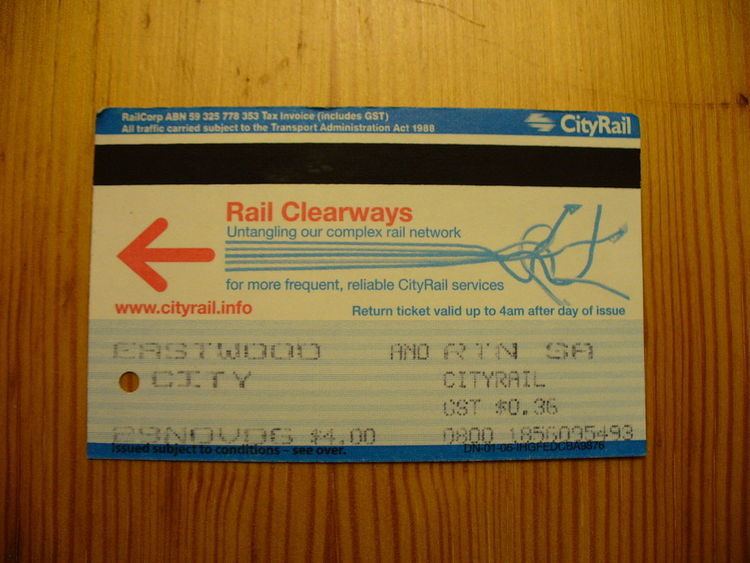 | ||
The Rail Clearways Program (formerly the CityRail Clearways Project) was a program of public works on Sydney's suburban railway network conceived in 2004 with the aim of easing congestion by reducing the amount of infrastructure shared by multiple services. The disparate projects at pinch points throughout the network were designed to increase capacity and improve reliability. All projects were delivered by the Transport Construction Authority until it was subsumed in November 2011 by Transport for New South Wales. Following the introduction of a new timetable in October 2013 that realised the benefit of many of the projects, the program was completed with the opening of the final upgrade in January 2014.
Contents
Conception
In the mid-2000s, the Government of New South Wales suffered heavy criticism for its perceived mishandling of the Sydney rail network, which had very poor on time performance following the January 2003 Waterfall train disaster. The safety regime introduced after this crash required drivers to stick to the speed limit, which often caused delays due to the expectations of the timetable for higher speeds. A slower, more realistic, timetable was introduced in September 2005, significantly improving on time running. The Clearways Program was intended to be the next step in improving on time performance.
Clearways routes
The Clearways Program aimed to divide the network's fourteen metropolitan rail lines into five independent "clearways" reducing the heavily interwoven nature of the Sydney system. This was intended to isolate incidents to one part of the network so other clearways would still run as scheduled, increasing on time performance. The clearways feed the existing lines through the Central Business District.
As the Carlingford Line does not run through the CBD, it was not included in any of the clearway routes. However, a Carlingford line upgrade was still included in the program, but this was cancelled in the November 2008 Mini-Budget. The Cumberland Line is spread across Clearways 4 and 5.
The five clearways routes are:
Clearway 1: Eastern Suburbs & Illawarra
This route did not change from the pre-clearways Eastern Suburbs & Illawarra Line. The projects undertaken on this route have increased capacity.
Clearway 2: Bankstown
After the Airport line opened in May 2000, most trains from the East Hills line used the new line to approach the city, easing congestion on the older line between Sydenham and Erskineville, where tracks are shared with Bankstown Line services. Under the program, new dedicated tracks for the Bankstown line between Sydenham and Erskineville were to be constructed to the west of the existing four tracks to allow express East Hills line trains from Clearway 3 to again run via Sydenham. The Airport line would be served by slower East Hills line trains from Clearway 4. Under the plan, St Peters and Erskineville railway stations were expected to continue to be served by the Bankstown line. This would have required platforms, partially completed in the 1970s as part of the Eastern Suburbs line construction, to have been activated at these two stations. The works were cancelled in November 2008, and the plan for frequent operation of express East Hills line services via Sydenham was abandoned.
A second Bankstown line project involved the construction of a new turnback platform at Lidcombe, separating the Bankstown line's operations from the former Inner West line (now part of the Airport, Inner West & South Line). This works in concert with the Homebush turnback project, which provides a terminating point for all stations trains on the Airport, Inner West & South Line. This separation was enacted in the October 2013 timetable.
Clearway 3: Campbelltown Express and Clearway 4: Airport & South
The Campbelltown Express Clearway would have separated the section of the East Hills line west of Revesby from the inner section that line by quaduplicating between Kingsgrove and Revesby and sending express services through to the City Circle via Sydenham. This was to allow more frequent express services to the City, relieve pressure on other parts of the network and improve the distribution of passengers.
On the Airport & South Clearway, limited stops services would have begun at Glenfield and made their way through Liverpool, Cabramatta, Granville, Lidcombe and Strathfield stations to the City Circle, while all-stations services to the City started at Homebush. After passing through the City Circle, trains would have headed south-west via the Airport to Revesby (running parallel with the Campbelltown Express line from Wolli Creek to Revesby).
In the October 2013 timetable these two clearways were merged to create the Airport, Inner West & South Line. Differences from the original plan include via Revesby and via Granville services sharing tracks between Glenfield and Macarthur, and all stations and limited stops services via Revesby sharing tracks between Revesby and Central. In the 2013 timetable most trains from Macarthur via Revesby use the local (pre-existing) tracks between Revesby and Wolli Creek and make a number of stops along the route. These trains approach the City via the Airport. The route via Sydenham and the express tracks between Wolli Creek and Revesby are only used by a limited number of peak hour services as well as NSW TrainLink services to Goulburn, Canberra, Griffith and Melbourne.
Clearway 5: North West
The North West Clearway provides an independent corridor for the North Shore, Northern & Western Line to improve reliability and capacity. Trains from the west start from the Richmond, Penrith or Epping branches, meet up at Strathfield and travel through the city to Chatswood. Here trains split, either continuing up the North Shore line to Berowra, or via the Chatswood to Epping line to Hornsby.
Projects
Many infrastructure upgrades need to be completed in order to implement the Clearways plan. These projects included upgrading stations, adding extra tracks, stabling facilities, or upgrading junctions. The projects included:
Resignalling
Non-clearways projects
Other projects of the era which were not part of the Rail Clearways program but will also improve the suburban passenger network include:
Cancelled projects included:
